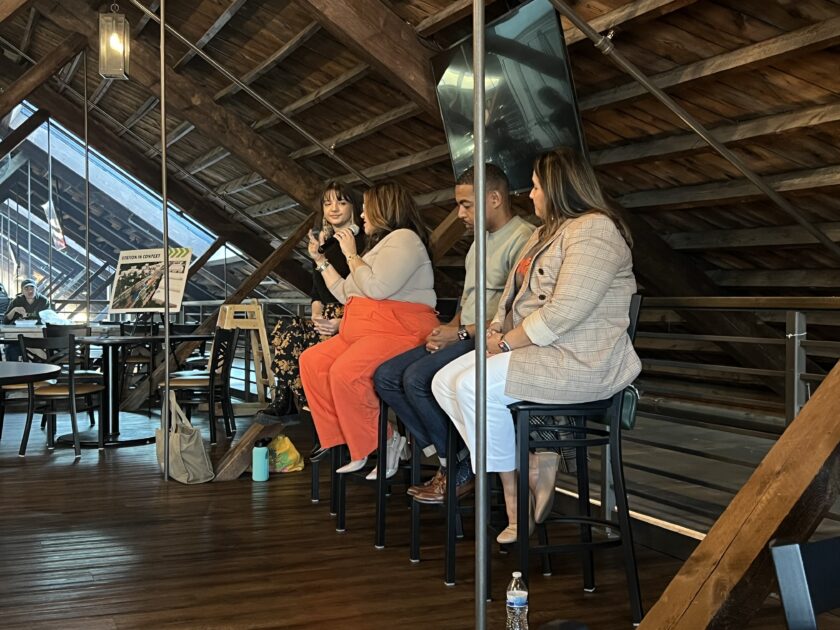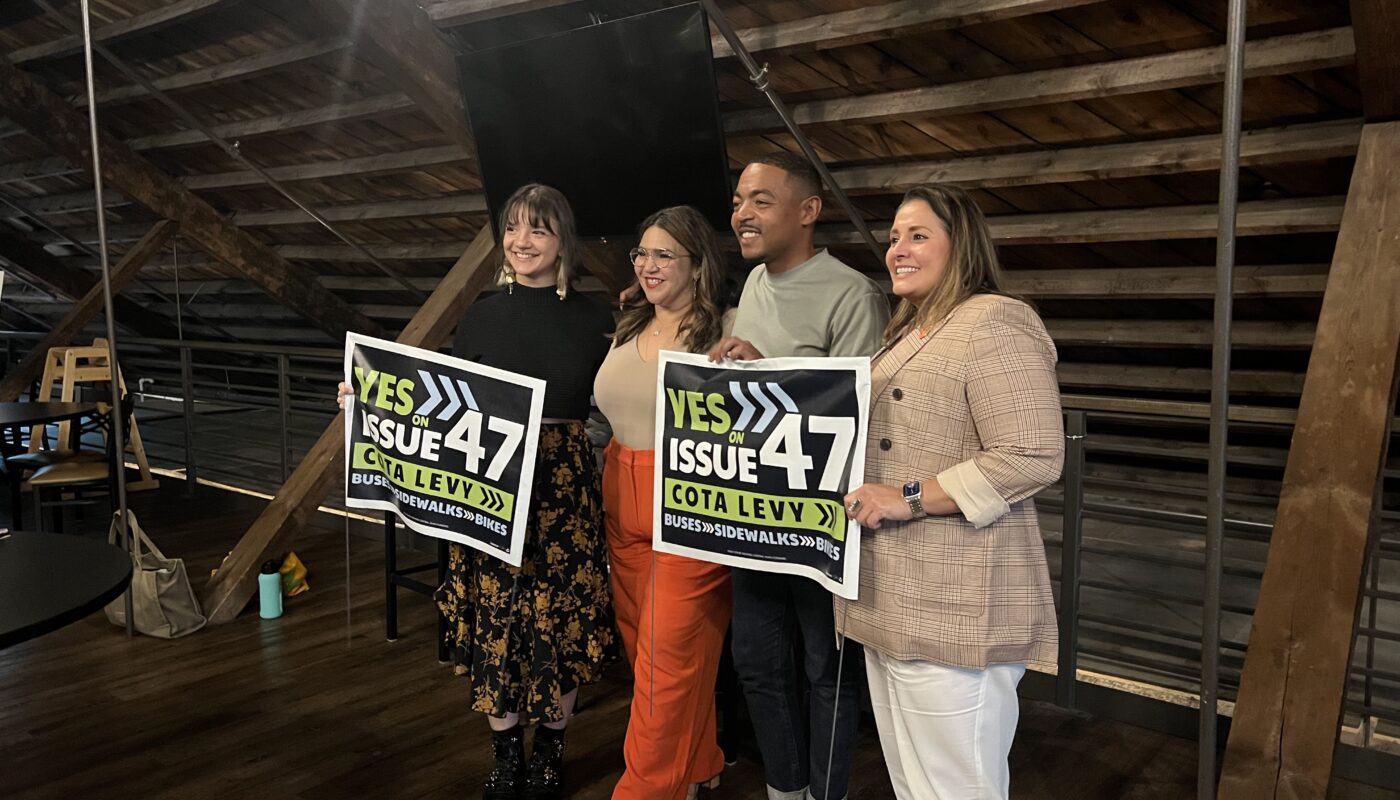From left to right: Stevie Pasamonte, Lourdes Barroso de Padilla, Shannon Hardin and Monica Tellez-Fowler pose for a group photo with Issue 47 lawn signs.
Transit Columbus, an advocacy group fighting for better public transit in Columbus, held a panel Oct. 8 discussing Issue 47 and the LinkUS initiative.
Photo by Marvin Wurr
The panel, moderated by Transit Columbus chair Stevie Pasamonte, included city council members Shannon Hardin and Lourdes Barroso de Padilla, and COTA CEO Monica Tellez Fowler.
Issue 47 on the November ballot is a sales tax levy that would increase Franklin County’s sales tax rate by 0.5% to accommodate COTA’s LinkUS initiative.
“We’re really looking to increase COTA services at 45%,” said Fowler. “What we’re really trying to get to is a better service in general. Really working towards having that 24-hour, seven days a week service that a region of our size really should have already.”
According to Fowler, this would include building five transit corridors in Columbus, including three bus rapid transit corridors already set aside for West Broad Street, East Main Street and the Northwest Corridor. Additionally, improvements are planned for the fourteen existing standard service COTA routes.
Fowler also acknowledged that the initiative would include the construction of additional sidewalks throughout Columbus to facilitate access to COTA’s transit system.

“When I was a kid growing up, my life was in like a five-mile radius of my house,” said de Padilla. “My doctor’s office wasn’t far away. I could walk to my middle school, elementary school and high school. People don’t live like that anymore, and so when we think about the growth that is coming to Columbus, we think about where all these folks are going to go…. So, when we talk about closing the access gap, we’re not just [talking] about closing it in terms of transit. We’re literally talking about changing how people are living and changing their accessibility to some of the services and where people can live in the city as well.”
Pasamonte noted that these improvements will be beneficial to car drivers.
“If you don’t want to be stuck in traffic,” said Pasamonte, “or if you don’t want to be sharing the road with a bicyclist because you’re worried that you may hit them, having separated bike lanes, for example, having better infrastructure for folks who are not using cars makes it easier for people to make that choice.”
Regarding the implementation of light rail in the city’s transit system, Fowler noted that a number of roadblocks are in place.
“What you really need in order to have a successful grant with the FTA (Federal Transit Administration) for light rail is density, and that’s currently something we don’t have,” said Fowler. “It doesn’t mean that we won’t have it in the future, and that we could look at light rail in the future.”
Speaking on the federal grants for the initiative, Hardin noted that the city needed to be able to match federal funding to get access to said grants.
“If we don’t pass [Issue 47],” said Hardin. “If we don’t get these revenues focused on transit, then we will miss out on more than a billion or more dollars.”
The panel also discussed the issue of convenience regarding public transit, with Pasamonte noting that people may have differing views on what COTA service means to them.
According to Fowler, COTA was severely affected by a recent labor shortage.
“Many of us probably remember that there was a labor shortage and COTA was hit really hard,” said Fowler. “I had the pleasure of coming in and being tasked with negotiating the contract with our frontline employees.”
Fowler added that this included implementing family paid leave policies.
“Really, it’s about the surrounding policy for all of our employees to demonstrate to them that we want to make sure that they are considered a partner in everything they do with us,” said Fowler. “We really focus on looking at our organization structure. Structure it in a way where we can start focusing on safety, customer experience and expansion.”
Commenting on the issue of convenience, Hardin stated it was not necessarily an issue with COTA.
“The truth is that it’s not a COTA issue,” said Hardin.”It’s that we have not invested in transit in central Ohio for a long time…I live out far East right now, and one of the corridors will go past my neighborhood on East Main Street. That’s how far out I live. If we do this right, in ten years, I will be sitting in traffic trying to get downtown, going down Main Street, and the Main Street BRT will be whizzing past me, and I’ll be sitting there thinking ‘Well, hell, I need to be on that thing that will get me there.’”
Speaking on how voters lean regarding Issue 47, Hardin notes that polling has been done on the matter.
“We polled this early in the year,” said Hardin. “It was at around 60% again…. We polled a couple weeks ago, we’re about 55, 56%. We’re not worried about that slippage, because really what that is is partisanship happening as we get closer to the election. Folks on the outer and outside of the city that will be voting on this are just starting to act like more traditional voters.”
Hardin adds that voters who are leaning “yes” are more enthusiastic about the levy.
“What we saw that really gets us excited is the percentage of voters who said that we are definitely voting for this [issue] surged,” said Hardin. “Great, great majority of those folks are like ‘we’re definitely coming out, we’re definitely voting for this.’”
Issue 47 will be on the upcoming November ballot for Franklin County voters.


